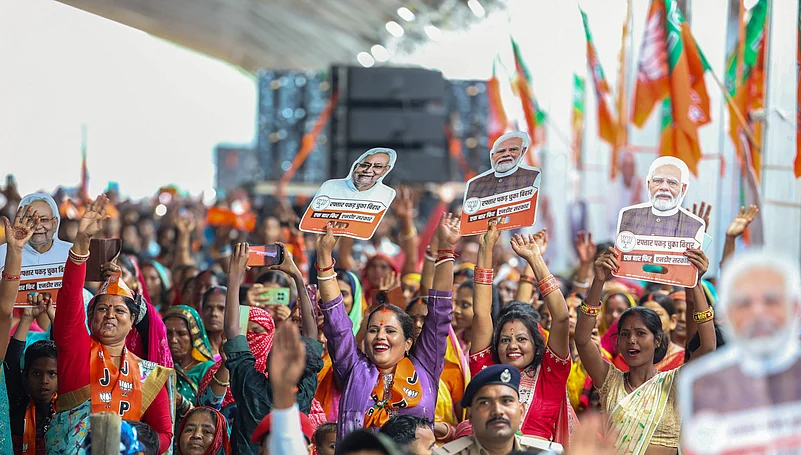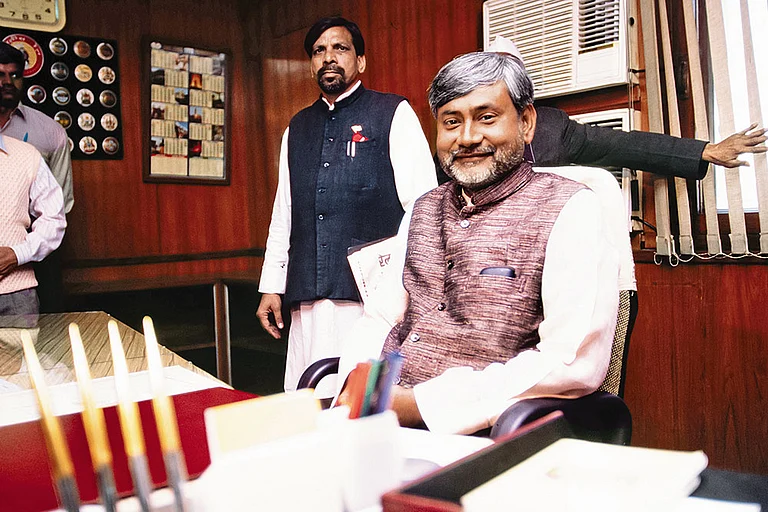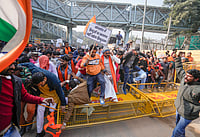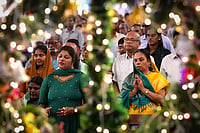
Prashant Kishor repeatedly invoked women in speeches and interviews, but this visibility did not translate into votes.
Women turned out in historic numbers, surpassing men and emerging as Bihar’s most decisive voting bloc.
Nitish’s decade-long welfare network including cycles, cash transfers, SHGs, prohibition, cemented a lived, trusted bond women weren’t willing to risk.
As counting unfolded today in Bihar, one trend that had been building through the campaign seems to have taken a shape with force. Women voters once again delivered for Chief Minister and JD(U) leader Nitish Kumar. This reaffirms a political relationship more than a decade in the making. This came despite an aggressive, last-minute push by the rivals.
While RJD leader and chief ministerial candidate Tejashwi Yadav announced a last-minute promise of ₹10,000 direct outreach to women, prominently, Prashant Kishor, did not leave a single rally or interview without talking about women. Yet, it seems none of these appeals matched the depth of Nitish’s credibility among Bihar’s women electorate. The question that’s also being asked is whether Kishor, who claimed that youth and migrants, and not women, were the X-factor of these elections, misread the depth of Nitish’s long-standing connection with women voters. Did Kishor’s pitch instead work against him?
Prashant Kishor, the founder of the Jan Suraaj Party, repeatedly criticised the state government’s ₹10,000 payout to Jeevika women, calling it an “officially declared bribe”. At a rally in Raghopur, Kishor said: “This is not welfare. This is an officially declared bribe. These are the same women who were once thrashed on Patna’s streets. Now days before polls they are being paid off.” In interviews, he doubled down: “In a poor state like Bihar, they are distributing ₹10,000 to 1.5 crore women during elections. Women are taking the money, but they are not foolish enough to compromise five years for it.”
Kishor often argued that women “on camera” were expressing fear of losing benefits if they didn’t vote for Nitish. But despite this relentless messaging, his show at the polls was dismal. Social scientist Ashwini Kumar, professor at the Tata Institute of Social Sciences, says that the biggest mistake Kishor made was ignoring the political and demographic heft of women. “He had no coherent strategy for Bihar’s women voters. While his focus on palayan and rozgar did resonate, he spoke about “youth” as if it were a single, genderless category, overlooking the fact that half of that population is women. And in 2025, women are no longer invisible,” he says.
“Kishor treated the youth as a monolith, as if it did not include women. That blind spot cost him. Women have become a decisive political force in Bihar, and any leader who ignores them is ignoring the new centre of electoral power,” he adds.
This election marked a significant shift as women turned out in record numbers and even surpassing men. Exit polls confirmed the trend. Women linked cycles, uniforms, cash transfers, scholarships, self-help groups, prohibition, and the visibility of welfare schemes directly to Nitish’s governance, according to women who came to vote across districts. “Nitish spoke less but had more work to show,” he said.
Analysts say their rhetoric lacked the depth, longevity, and credibility of Nitish’s decade-long welfare architecture. “Campaigns used to revolve around caste arithmetic. Now they revolve around women,” says Prof. Kumar. “Nitish understood this earlier than anyone else. Women have been experiencing his schemes directly. Their loyalty is not ideological. It is lived. The others came with speculative promises, not a record,” he adds
In a campaign crowded with promises, women placed their trust in continuity. According to senior journalist Neerja Chowdhury Nitish built much of his political legacy around women. Cycles, uniforms, prohibition, self-help groups, reservations, and more bank accounts in women’s names.
Interestingly, for JD(U), wherever women turned out in large numbers, the party’s vote share jumped to 23.8 percent. But in places where men and women voted in roughly the same proportion, JD(U) fell to just 15.7 percent. Women aren’t even equal on the voter list as Bihar still has 42 lakh more men registered to vote than women. But on polling day, it was women who took charge as four lakh more women voted than men. Their turnout was a striking 71.6 per cent, compared to 62.8 percent for men.
“Voting is an emotional decision,” says psephologist Amitabh Tiwari. “With reservations in panchayats and jobs, women’s confidence increased. The liquor ban reduced domestic violence. Voting is an emotional decision,” he adds.
And in 2025, that emotion once again went decisively Nitish Kumar’s way.








.png?auto=format%2Ccompress&fit=max&format=webp&w=768&dpr=1.0)

















